




Your support is critical to our success.
Accepted Scientific Name: Conophytum bilobum var. elishae (N.E.Br.) S.A.Hammer
Dumpling & His Wife: New Views of Gen. Conophytum 85 (2002). Remarks: Basionym not stated
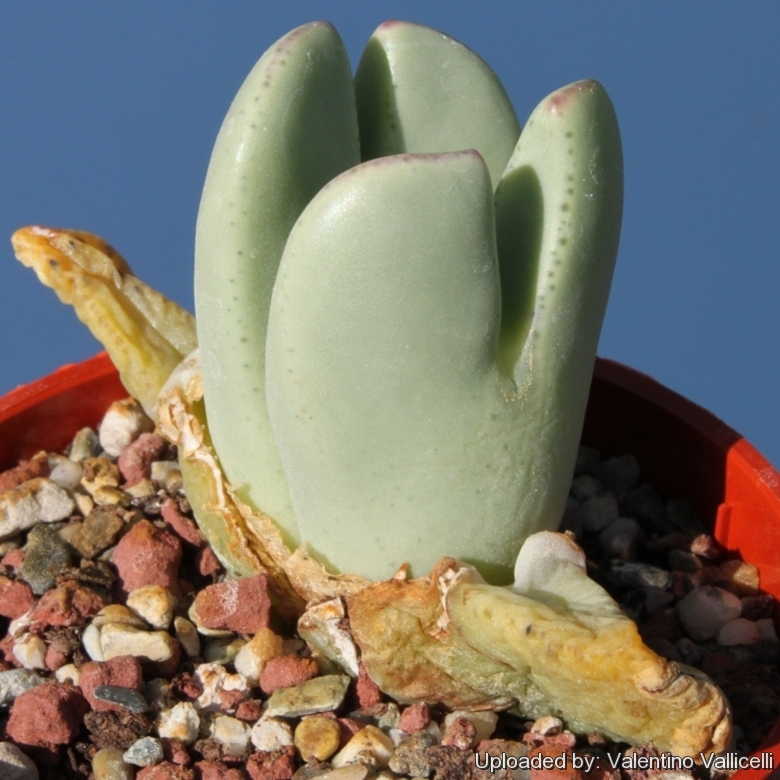
Origin and Habitat: Cape Province, South Africa.
Synonyms:
- Conophytum bilobum var. elishae (N.E.Br.) S.A.Hammer
- Conophytum elishae N.E.Br.
- Derenbergia elishae (N.E.Br.) Schwantes
- Mesembryanthemum elishae N.E.Br.
Conophytum bilobum (Marloth) N.E.Br.
Gard. Chron. 1922, Ser. III. lxxii. 83.
Synonymy: 122
- Conophytum bilobum (Marloth) N.E.Br.
- Derenbergia biloba (Marloth) Schwantes
- Mesembryanthemum bilobum Marloth
- Conophytum absimile L. Bolus
- Conophytum absimile var. major L. Bolus
- Conophytum absimile f. majus L. Bolus
- Conophytum absimile f. umbrosum L. Bolus
- Conophytum aequale L. Bolus
- Conophytum albescens N.E.Br.
- Mesembryanthemum albescens (N.E.Br.) hort.
- Conophytum ampliatum L. Bolus
- Conophytum amplum L. Bolus
- Conophytum andausanum N.E.Br.
- Conophytum andausanum var. immaculatum L. Bolus
- Conophytum angustum L. Bolus
- Conophytum angustum N.E.Br.
- Conophytum anomalum L. Bolus
- Conophytum apiatum N.E.Br.
- Derenbergia apiata (N.E.Br.) Schwantes
- Mesembryanthemum apiatum N.E.Br.
- Conophytum apiculatum N.E.Br.
- Conophytum approximatum Lavis
- Conophytum auctum f. approximatum (Lavis) Rawé
- Conophytum asperulum L. Bolus
- Conophytum asperulum var. brevistylum L. Bolus
- Conophytum auctum N.E.Br.
- Conophytum australe L. Bolus
- Conophytum barkerae L. Bolus
- Conophytum beekenkampianum Tischer
- Conophytum brevisectum L. Bolus
- Conophytum cauliferum N.E.Br.
- Derenbergia caulifera (N.E.Br.) Schwantes
- Mesembryanthemum cauliferum (N.E.Br.) hort.
- Conophytum cauliferum var. lekkersingense L. Bolus
- Conophytum christiansenianum L. Bolus
- Conophytum citrinum L. Bolus
- Conophytum compressum N.E.Br.
- Conophytum conradii L. Bolus
- Conophytum convexum L. Bolus
- Conophytum cordatum Schick & Tischer
- Conophytum cordatum var. macrostigma L. Bolus
- Conophytum coriaceum L. Bolus
- Conophytum crassum L. Bolus
- Conophytum curtum L. Bolus
- Conophytum dennisii N.E.Br.
- Conophytum difforme L. Bolus
- Conophytum dilatatum Tischer
- Conophytum dissimile L. Bolus
- Conophytum distans L. Bolus
- Conophytum divaricatum N.E.Br.
- Conophytum diversum N.E.Br.
- Conophytum dolomiticum Tischer
- Conophytum ecarinatum L. Bolus
- Conophytum ecarinatum var. angustum L. Bolus
- Conophytum ecarinatum var. mutabile
- Conophytum excisum L. Bolus
- Conophytum exsertum N.E.Br.
- Conophytum furcatum N.E.Br.
- Conophytum geminum N.E.Br.
- Conophytum glaucum N.E.Br.
- Conophytum gonapense L. Bolus
- Conophytum gonapense var. numeesicum L. Bolus
- Conophytum grandiflorum L. Bolus
- Conophytum gregale N.E.Br.
- Conophytum igniflorum n.n.
- Conophytum inclusum L. Bolus
- Conophytum incurvum N.E.Br. & Tischer
- Conophytum incurvum var. leucanthum (Lavis) Tischer
- Conophytum indefinitum L. Bolus
- Conophytum insigne L. Bolus
- Conophytum klipbokbergense L. Bolus
- Conophytum kubusbergense Tischer
- Conophytum largum L. Bolus
- Conophytum latum L. Bolus
- Conophytum lavisianum L. Bolus
- Conophytum laxipetalum N.E.Br.
- Conophytum lekkersingense L. Bolus
- Conophytum leucanthum Lavis
- Conophytum leucanthum var. multipetalum L. Bolus
- Conophytum macrostigma (L. Bolus) Schwantes
- Conophytum markoetterae Schwantes
- Conophytum meyerae Schwantes
- Conophytum meyerae f. alatum Tischer
- Conophytum meyerae f. apiculatum (N.E.Br.) Tischer
- Conophytum meyerae f. asperulum (L. Bolus) H.Jacobsen
- Conophytum meyerae f. pole-evansii (N.E.Br.) Tischer
- Conophytum nelianum Schwantes
- Conophytum noisabisense L. Bolus
- Conophytum nutaboiense Tischer
- Conophytum obtusum N.E.Br.
- Conophytum obtusum var. amplum (L. Bolus) Rawé
- Conophytum ovatum L. Bolus
- Conophytum parvulum L. Bolus
- Conophytum philippii L. Bolus
- Conophytum piriforme L. Bolus
- Conophytum plenum N.E.Br.
- Conophytum pluriforme L. Bolus
- Conophytum pole-evansii N.E.Br.
- Conophytum proximum L. Bolus
- Conophytum proximum Schwantes
- Mesembryanthemum proximum N.E.Br.
- Conophytum recisum N.E.Br.
- Conophytum simile N.E.Br.
- Conophytum simplum N.E.Br.
- Conophytum sitzlerianum Schwantes
- Conophytum smithersii L. Bolus
- Conophytum sororium N.E.Br.
- Conophytum springbokense N.E.Br.
- Conophytum strictum L. Bolus
- Conophytum strictum var. inaequale L. Bolus
- Conophytum stylosum (N.E.Br.) Tischer
- Mesembryanthemum stylosum N.E.Br.
- Conophytum subacutum L. Bolus
- Conophytum subcylindricum L. Bolus
- Conophytum subtenue L. Bolus
- Conophytum supremum L. Bolus
- Conophytum tectum N.E.Br.
- Conophytum tumidum N.E.Br.
- Conophytum tumidum var. asperulum L. Bolus
- Conophytum umdausense L. Bolus
- Conophytum variabile L. Bolus
- Conophytum vlakmynense L. Bolus
Conophytum bilobum subs. altum (L. Bolus) S.A.Hammer
Gen. Conophytum
Synonymy: 12
- Conophytum bilobum subs. altum (L. Bolus) S.A.Hammer
- Conophytum altum L. Bolus
- Conophytum altum var. plenum L. Bolus
- Conophytum apertum Tischer
- Conophytum connatum L. Bolus
- Conophytum corniferum Schick & Tischer
- Conophytum durnale N.E.Br.
- Conophytum gracile N.E.Br.
- Conophytum gracile var. majusculum L. Bolus
- Conophytum graciliramosum L. Bolus
- Conophytum luiseae Schwantes
- Conophytum luiseae var. papillatum L. Bolus
Conophytum bilobum subs. claviferens S.A.Hammer
Dumpling & His Wife: New Views of Gen. Conophytum 86 (2002).
Accepted name in llifle Database:
Conophytum bilobum var. elishae (N.E.Br.) S.A.Hammer
Dumpling & His Wife: New Views of Gen. Conophytum 85 (2002).
Synonymy: 4
- Conophytum bilobum var. elishae (N.E.Br.) S.A.Hammer
- Conophytum elishae N.E.Br.
- Derenbergia elishae (N.E.Br.) Schwantes
- Mesembryanthemum elishae N.E.Br.
Conophytum bilobum subs. gracilistylum (L. Bolus) S.A.Hammer
Gen. Conophytum 242, without basionym ref. 1993
Synonymy: 10
- Conophytum bilobum subs. gracilistylum (L. Bolus) S.A.Hammer
- Conophytum gracilistylum N.E.Br.
- Derenbergia gracilistyla (L. Bolus) Schwantes
- Mesembryanthemum gracilistylum L. Bolus
- Conophytum chauviniae (Schwantes) S.A.Hammer
- Conophytum bilobum subs. gracilistylum f. chauviniae (Schwantes)
- Conophytum gracilistylum f. chauviniae (Schwantes)
- Derenbergia chauviniae (Schwantes) Schwantes
- Mesembryanthemum augeiforme Schwantes
- Mesembryanthemum chauviniae Schwantes
Conophytum bilobum lacteum hort.
n. n., nov. comb. ined. [as: Conophytum lacteum L. Bolus 1967]
Synonymy: 2
- Conophytum bilobum lacteum hort.
- Conophytum lacteum L. Bolus
Conophytum bilobum var. linearilucidum (Lavis) S.A.Hammer
Dumpling & His Wife: New Views of Gen. Conophytum 85 (2002).
Synonymy: 2
- Conophytum bilobum var. linearilucidum (Lavis) S.A.Hammer
Conophytum bilobum var. muscosipapillatum (Lavis) S.A.Hammer
Dumpling & His Wife: New Views of Gen. Conophytum 85 (2002).
Synonymy: 2
- Conophytum bilobum var. muscosipapillatum (Lavis) S.A.Hammer
RUSSIAN (Русский): Конофитум
Description: Conophytum bilobumSN|1166]]SN|1166]] var. elishae is another large growing bi-lobed species of the Conophytum bilobumSN|1166]]SN|1166]] complex which comprises many morphological and geographical variant that was early classified as different independent species. Nowadays all this plant are considered part of a multiform species, where each form is linked to others by populations of plants with intermediate characteristics. It is a small but robust caespitose (groundcover) plant that resembles a cluster of pebbles often well camouflaged to resemble the surroundings. Conophytum bilobumSN|1166]]SN|1166]] var. elishae distinguish for a transparent zone that can be seen just below the fissure and extends down-wards. The species increases quickly and eventually forms an attractive clump.
Stem: Stemless or with short stems with time.
Bodies (paired leaves): About 2,5 centimetres tall, blue-green. The leaf-tips (lobes) are cleft (V-shaped free in profile) and keeled. A transparent zone can be seen just below the fissure and extends down-wards. The margins are green or purplish in colour.
Flowers: Bright yellow.
Blooming season: The flowers are autumnal and diurnal.
Subspecies, varieties, forms and cultivars of plants belonging to the Conophytum bilobum group
 Conophytum apertum Tischer: (subs. altum) differs from Conophytum bilobum subs. altum in that it has pronounced wide open lobes
Conophytum apertum Tischer: (subs. altum) differs from Conophytum bilobum subs. altum in that it has pronounced wide open lobes  Conophytum apiatum N.E.Br.: (subs. bilobum) has conspicuous dots upon its whitish-green surface. Distribution: Remhoogte and adjacent areas, Little Namaqualand, South Africa.
Conophytum apiatum N.E.Br.: (subs. bilobum) has conspicuous dots upon its whitish-green surface. Distribution: Remhoogte and adjacent areas, Little Namaqualand, South Africa. Conophytum bilobum (Marloth) N.E.Br.: It is a very variable taxon with short internodes, leaf-tips (lobes) free, leaves 1 to 6 cm long, more or less triangular in shape and keeled. The flowers are large yellow.
Conophytum bilobum (Marloth) N.E.Br.: It is a very variable taxon with short internodes, leaf-tips (lobes) free, leaves 1 to 6 cm long, more or less triangular in shape and keeled. The flowers are large yellow.- Conophytum bilobum subs. altum (L. Bolus) S.A.Hammer: has long internodes long with depauperate bodies, and small flowers.
 Conophytum bilobum var. elishae (N.E.Br.) S.A.Hammer: large growing bi-lobed species. A transparent zone can be seen just below the fissure and extends downwards.
Conophytum bilobum var. elishae (N.E.Br.) S.A.Hammer: large growing bi-lobed species. A transparent zone can be seen just below the fissure and extends downwards. Conophytum bilobum subs. gracilistylum (L. Bolus) S.A.Hammer: has very slender, long-lobed, pale green bodies with a fine spotting, with pale pink flowers. Distribution: northwest of Bitterfontein, West Cape Province, South Africa.
Conophytum bilobum subs. gracilistylum (L. Bolus) S.A.Hammer: has very slender, long-lobed, pale green bodies with a fine spotting, with pale pink flowers. Distribution: northwest of Bitterfontein, West Cape Province, South Africa. Conophytum bilobum lacteum hort.: White flowering form. Distribution: Kuboos mountains, Richtersveld, Little Namaqualand, Western Cape, South Africa.
Conophytum bilobum lacteum hort.: White flowering form. Distribution: Kuboos mountains, Richtersveld, Little Namaqualand, Western Cape, South Africa.  Conophytum chauviniae (Schwantes) S.A.Hammer: (subs. gracilistylum) has leaf-tips free and triangular with deep red markings. Flowers pink to magenta with a prominent perianth tube. Distribution: Namaqualand, Western Cape, South Africa.
Conophytum chauviniae (Schwantes) S.A.Hammer: (subs. gracilistylum) has leaf-tips free and triangular with deep red markings. Flowers pink to magenta with a prominent perianth tube. Distribution: Namaqualand, Western Cape, South Africa.  Conophytum christiansenianum L. Bolus: (subs. bilobum) has robust bodies 7 cm tall, 3 cm wide, leaf-tips free, 10-40 mm long, triangula and keeled. Flower yellow up to 3 cm. Distribution: Namaqualand, Western Cape, South Africa.
Conophytum christiansenianum L. Bolus: (subs. bilobum) has robust bodies 7 cm tall, 3 cm wide, leaf-tips free, 10-40 mm long, triangula and keeled. Flower yellow up to 3 cm. Distribution: Namaqualand, Western Cape, South Africa.  Conophytum conradii L. Bolus: (subs. bilobum) Bodies 3,5 centimetres long and 9 mm whide, deep green, leaf-tips free, triangular and keeled. Flowers scentless yellow. Distribution: Cape Province, South Africa.
Conophytum conradii L. Bolus: (subs. bilobum) Bodies 3,5 centimetres long and 9 mm whide, deep green, leaf-tips free, triangular and keeled. Flowers scentless yellow. Distribution: Cape Province, South Africa. Conophytum cordatum Schick & Tischer: (subs. bilobum) has pink-violet blooms, bodies 20-25 mm high, 12-15 mm broad, and 8-10 mm thick cordate (heart-shaped) in outline and keeled. Distribution: western part of South Africa.
Conophytum cordatum Schick & Tischer: (subs. bilobum) has pink-violet blooms, bodies 20-25 mm high, 12-15 mm broad, and 8-10 mm thick cordate (heart-shaped) in outline and keeled. Distribution: western part of South Africa. Conophytum corniferum Schick & Tischer: (subs. altum) The shape of the bodies are as a normal altum and the internodes are somewhat elongated as expected for that subspecies.
Conophytum corniferum Schick & Tischer: (subs. altum) The shape of the bodies are as a normal altum and the internodes are somewhat elongated as expected for that subspecies. Conophytum gracile N.E.Br.: (subs. altum) has short, erect, stems which are covered with old leaf sheaths. Distribution: Cape province, Little Namaqualand.
Conophytum gracile N.E.Br.: (subs. altum) has short, erect, stems which are covered with old leaf sheaths. Distribution: Cape province, Little Namaqualand.  Conophytum igniflorum n.n.: has fiery orange flowers in autumn that set this species apart from other bilobed Conophytums. It could be a natural hybrid. Origins unknown exactly.
Conophytum igniflorum n.n.: has fiery orange flowers in autumn that set this species apart from other bilobed Conophytums. It could be a natural hybrid. Origins unknown exactly. Conophytum lavisianum L. Bolus: (subs. bilobum) It is a southern "bilobum" form with bare body.
Conophytum lavisianum L. Bolus: (subs. bilobum) It is a southern "bilobum" form with bare body.- Conophytum luiseae Schwantes: (subs. altum)
 Conophytum meyerae Schwantes: (subs. bilobum) is one of the largest and robust forms. Bodies 6 cm tall 6 cm wide. the leaf-tips are heart-shaped and keeled. Distribution: Little Namaqualand
Conophytum meyerae Schwantes: (subs. bilobum) is one of the largest and robust forms. Bodies 6 cm tall 6 cm wide. the leaf-tips are heart-shaped and keeled. Distribution: Little Namaqualand Conophytum noisabisense L. Bolus: (subs. bilobum) Distribution: Little Namaqaland.
Conophytum noisabisense L. Bolus: (subs. bilobum) Distribution: Little Namaqaland. Conophytum ovatum L. Bolus: (subs. bilobum) has broader paired leaves and smaller flowers. Distribution: Namaqualand, South Africa.
Conophytum ovatum L. Bolus: (subs. bilobum) has broader paired leaves and smaller flowers. Distribution: Namaqualand, South Africa. Conophytum piriforme L. Bolus: has robust piriform (pear-shaped) bodies narrowed toward the apex. Distribution: Kuboos mountains, Richtersveld, Little Namaqualand, North-West Cape Province, South Africa.
Conophytum piriforme L. Bolus: has robust piriform (pear-shaped) bodies narrowed toward the apex. Distribution: Kuboos mountains, Richtersveld, Little Namaqualand, North-West Cape Province, South Africa. Conophytum pluriforme L. Bolus: (subs. bilobum) bodies variable in shape.
Conophytum pluriforme L. Bolus: (subs. bilobum) bodies variable in shape. Conophytum simplum N.E.Br.: (subsp. bilobum) has small, almost cylindrical bodies 40-50 mm high, 10-12 mm thick lobes erect, 6 mm long and wide. Distribution: Cape province, Little Namaqualand.
Conophytum simplum N.E.Br.: (subsp. bilobum) has small, almost cylindrical bodies 40-50 mm high, 10-12 mm thick lobes erect, 6 mm long and wide. Distribution: Cape province, Little Namaqualand.  Conophytum supremum L. Bolus: (subs. bilobum) Thickness 3 cm, height 7 cm. Leaf-tips free and are 10 mm long, triangular and keeled. Margins green to purple. Distribution: Northern Cape and Little Namaqualand.
Conophytum supremum L. Bolus: (subs. bilobum) Thickness 3 cm, height 7 cm. Leaf-tips free and are 10 mm long, triangular and keeled. Margins green to purple. Distribution: Northern Cape and Little Namaqualand. Conophytum variabile L. Bolus: (subs. bilobum)
Conophytum variabile L. Bolus: (subs. bilobum) Conophytum vlakmynense L. Bolus: (subs. bilobum) Big, fat, bi-lobed species, with broad pale greyish green bodies.
Conophytum vlakmynense L. Bolus: (subs. bilobum) Big, fat, bi-lobed species, with broad pale greyish green bodies.
Bibliography: Major references and further lectures
1) James Cullen, Sabina G. Knees, H. Suzanne Cubey “The European Garden Flora Flowering Plants: A Manual for the Identification of Plants Cultivated in Europe, Both Out-of-Doors” Cambridge University Press, 11/Aug./2011
2) Raimondo, D., von Staden, L., Foden, W., Victor, J.E., Helme, N.A., Turner, R.C., Kamundi, D.A. and Manyama, P.A. 2009. “Red List of South African Plants.” Strelitzia 25. South African National Biodiversity Institute, Pretoria.
3) Hammer, S. 1993. “The Genus Conophytum - A Conograph.” Succulent Plant Publications, Pretoria.
4) Hammer, S. 2002. “Dumpling and His Wife: New Views of the Genus Conophytum.” East Anglia Engraving Creative Colour Ltd, Norwich, England.
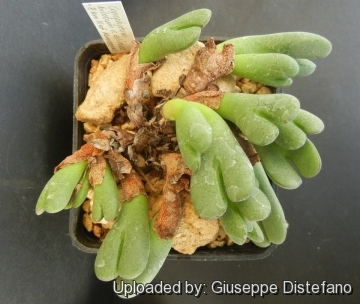
CR1038 8 km N of Komaggas (Conophytum bilobum var. elishae) Photo by: Giuseppe Distefano
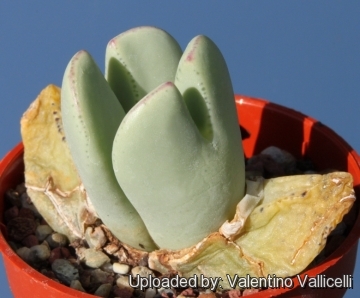
Mesembryanthemum elishae (Conophytum bilobum var. elishae) Photo by: Valentino Vallicelli
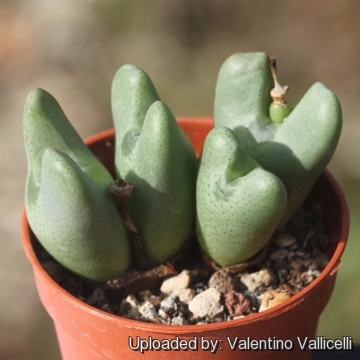
Conophytum elishae LAV27947 Komaggas Pass, Northern Cape, South Africa.jpg (Conophytum bilobum var. elishae) Photo by: Valentino Vallicelli
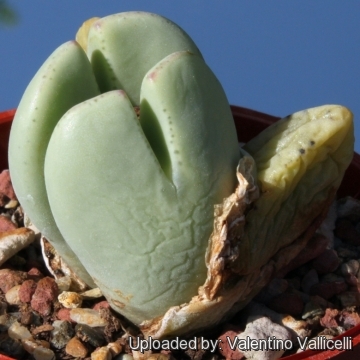
Mesembryanthemum elishae (Conophytum bilobum var. elishae) Photo by: Valentino Vallicelli
Cultivation and Propagation: It is a "winter" grower which is most active from late winter until later spring and heading for summer dormancy, but in favourable growing conditions it keeps going over the summer too and doesn't need particular care. All the forms of Conophytum bilobumSN|1166]]SN|1166]] are easy to grow.
Soil: Requires good drainage as it it is prone to root rot. It can grows outdoor in sunny, dry, rock crevices (protection against winter wet is required) It can also be cultivated in alpine house, in poor, drained soil.
Watering: It requires little water; otherwise its epidermis breaks (resulting in unsightly scars). Water minimally in summer, (only when the plant starts shrivelling), but it will generally grow even in summer if given water. Water regularly in winter after the previous year's leaves have dried up. Requires good drainage.
Fertilization: Feed it once during the growing season with a fertilizer specifically formulated for cactus succulents (poor in nitrogen), including all micro nutrients and trace elements diluted to ½ the strength recommended on the label. It thrives in poor soils and need a limited supplies of fertilizer to avoid the plants developing excess vegetation, which is easily attacked by fungal diseases.
Exposure: Keep cool and shaded in summer, it needs full sun or light shade.
Temperature: Hardy to -2°C. Ensure a very good ventilation.
Repotting: Avoid to repot frequently. This plant may stay in the same pot for many years.
Uses: Container, rock garden.
Pests and diseases: It is vulnerable to mealybugs and rarely scale.
Propagation: It can be reproduced both by cuttings and seeds. Take the cutting from a grown-up mother plant. Each cutting must contain one or more heads along with a fraction of root. It is easily propagated by seed. The small seeds can be sown in pots of fine, well-drained sand, any time during the spring and summer months when temperatures are warm. Cover the seeds with a very fine layer of grit and water from below with a fungicide to prevent damping off. For the first 3-4 days cover the pots with a sheet of glass/clear perspex to keep the humidity levels high. Remove the glass and replace it with light shadecloth and mist once or twice a day for the next two weeks after which most seeds should have germinated. From then on mistings can be reduced to every second and then every third day as the little plants grow.
| Your Actions | |
|---|---|
| Back to Mesembryanthemum index | |
| Back to Aizoaceae index | |
 |
Back to Succulents Encyclopedia index |
Privacy stantement - Terms and conditions - How to cite - About us - Feedback - Donate



